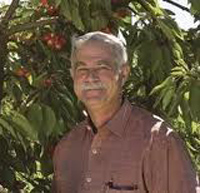
Varieties Part 2:
In 1938 Dave Wilson established a Nursery on a small piece of ground near Modesto. Today the Dave Wilson Nursery (DWN) is one of the largest growers of fruit and nut trees in California. The DWN is still a family owned and operated business run by Jane and Robert Woolley, Dave’s granddaughter and grandson-in-law.
Farmer Al’s been buying trees from DWN for close to 30 years. When thinking about adding a new variety to the orchard, Al respects and values Robert’s opinion highly. Some interesting and innovative things are going on at the DWN that have a lot of influence on the varieties that are brought to market for both farmers and home gardeners alike.
DWN nursery supplies trees to three market channels- large commercial fruit growers, direct market growers like FHF, and home garden centers. Each of these market channels have specific needs and wants. As we touched on last week, for farms like ours that sell directly to consumers, one of the most important characteristics in a variety is flavor. Of course, there are other considerations like productivity and disease resistance, but flavor is a very key component. For large commercial growers, the fruit needs to withstand storage and transport, be uniform in size (larger the better), have specific color characteristics, and be highly productive.
In order to identify the varieties that are best suited to each market channel, DWN does rigorous testing and evaluations of all their varieties. The trees are trained, pruned, and thinned the way a farmer would handle trees, as opposed to a home gardener. But a large part of their research deals with harvest time and handling. Because it is hard to predict what fruit will taste and feel like after two weeks of handling, which is very typical of large commercially produced fruit, they have invested in equipment that enables them to create a facsimile of commercial conditions.
In testing varieties for large commercial sale, they harvest the fruit at specific times. For peaches and nectarines it is harvested at a level of maturity titled “CA well matured” where the fruit has a butter color but no red pigment in the under color, and it is firm. At DWN they place the “CA well matured” fruit in cold storage for 10 days, which is average for large commercial operations. Robert says the range for cold storage post harvest in large commercial operations is between 3-30 days for peaches and nectarines. After the fruit is removed from cold storage, it is warmed up and then cooled back down. This treatment is called preconditioning and is done to trigger ripening in the fruit. Finally, DWN puts the fruit into conditions that approximate commercial transport and shelving conditions. At the end of all this, they test the fruit for firmness, flavor, and Brix, which is a sugar scale. If the variety held up to all of the steps above and has a good flavor, it is marketable for large commercial operations.
Robert tells me that when testing the same varieties for direct market farm operations, they let the fruit hang on the tree for 10-30 days longer! Brix levels, flavor, and texture are the primary criteria for success as a variety for direct market growers, but also what will render a variety economically viable as far as productivity. What DWN hopes to find through all of this testing are varieties that have potential to taste delicious and succeed in both large commercial handling and direct market conditions.
Robert’s motivation for rigorous variety testing began 25 years ago when he was with Floyd Zaiger at his orchard with three of the largest commercial growers in CA. Zaiger cut a slice of one of his newly developed nectarines to share the flavor and one of the growers told Zaiger that he didn’t care what the fruit tasted like, but wanted firmness and color. In those days fruit would rot before it got soft. Today, Robert wants to find fruit that can make it through the commercial chain and still have very good flavor, as well as to find varieties that can truly shine in all their potential for flavor and texture when allowed to mature on the tree.
Thanks Robert for all your hard work and advice!

 Follow
Follow
